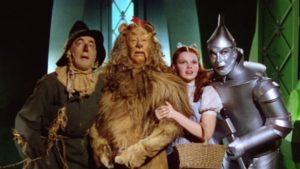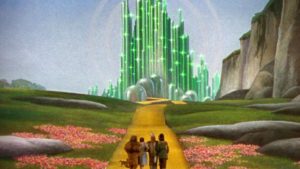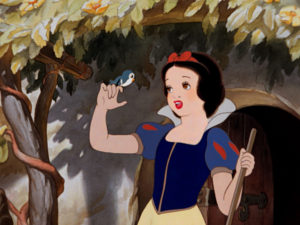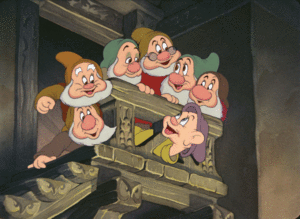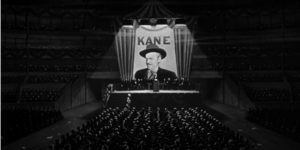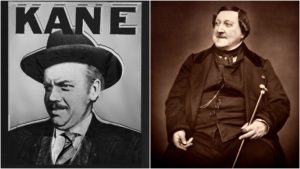- A shot in a movie that is of a different subject from those to which it is joined in editing.
- In film and video, a cutaway shot is the interruption of a continuously filmed action by inserting a view of something else.
- For instance, a shot of a high school teacher lecturing to his students is followed by another one of the principal standing at the door listening. Then back to the shot of the teacher lecturing. The shot of the principal is the cutaway shot.
- Continuity, as it relates to filmmaking or videography, refers to maintaining believable and temporal relationships within a scene in such a way that shots you intend to put together actually fit together in a natural and seamless flow of action, preserving the illusion of reality on the screen.
- Use cutaways to solve continuity problems such as jump cuts.
- Imagine another scene with a man working on a laptop sitting on a train, embarking on a long journey cross-country. Where is he going? What is he thinking? A cutaway out the train window shows passing farmland; the next shot shows him with an overnight bag slung over his shoulder, getting off the train. Clearly, without needing to say it, using only your cutaways, you’ve painted a picture of a businessman going to the city.
- You automatically raise the stakes when you shoot a harried woman with her arms full of groceries unlocking and closing the door to her house at twilight, then you follow up with a cutaway of a set of dangling keys she left behind, still in the keyhole.
- For an illustration to fulfill the purposes for which it is designed, it is often important that certain objects depicted not be blocked by others.
What is the concept?
The major use of a cutaway is to “guide the audience from subject to subject, and on occasion, to place the audience in the position of the actors” (Gessner 89).
It is important to choose cutaway shots that truly represent what the characters are feeling or thinking about or shots of objects – anything that serves the story, not just something you can use as a Band Aid to cover cuts. This is where the art of the cutaway truly lies. You could call this the art of momentarily distracting the audience. In the end, that’s what a cutaway truly is: a momentary distraction to the audience to serve the story.
What are different versions of the concept?
Different versions or types of ways cutaway shots can serve the film include:
- Time Control — Cutaways can emphasize important details or add detail and meaning to a scene. From the cutaway shot of the clock, the audience might rightfully assume some of the following: the woman has to be somewhere on time, she’s probably late and therefore is in a hurry, etc. The assumptions are infinite. Of course, the shot immediately preceding the cutaway and the one that follows it, as well as the context of the scene (whether the woman is actually looking at the clock, her facial expressions, her overall demeanor, etc.), will help in the interpretation.
- Unspoken Words — Use cutaways to increase tension in your scenes. You automatically raise the stakes when you shoot a harried woman with her arms full of groceries unlocking and closing the door to her house at twilight, then you follow up with a cutaway of a set of dangling keys she left behind, still in the keyhole. The audience will have no problem coming to the appropriate conclusions or assumptions.
- Linking Action — You want to break or link action in scenes? Use cutaways. Jump people around by moving them from place to place? Cutaways. Use them for suspense or excitement, to reveal information, to smoothly join one part of the speech in a dialogue with another, to fix screen direction mistakes, even to confuse the audience. Be careful not to resort to cheap cutaways, which will make you look like the newcomer on the block. A cutaway shot whose sole purpose is to mask an overt mistake reminds the audience – or especially a trained eye – that something was fixed or removed. It is a delicate balance.
Sources
- https://www.videomaker.com/article/13850-the-art-of-the-cutaway (Links to an external site.)
- https://en.wikipedia.org/wiki/Cutaway_(filmmaking) (Links to an external site.)
- https://link.springer.com/article/10.1007/BF01897116
- https://www.jstor.org/stable/pdf/774257.pdf?ab_segments=0%252Fdefault-2%252Fcontrol&refreqid=excelsior%3A81ed36f863f25b2e5c3a784155aed674 (Links to an external site.)
- https://www.videomaker.com/article/13850-the-art-of-the-cutaway (Links to an external site.)

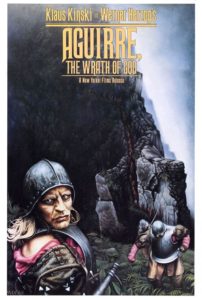 Aguirre, the Wrath of God is a West German-Mexican-Peruvian historical drama. It was directed by Werner Herzog, a German director, in the year 1972. The story takes place in 16th-century Peru. In the beginning the camera pans over a beautiful view of the Andes mountains. On those mountains was a large group of Spanish conquistadors on their mission to find the mythical city El Dorado. The travelers believed that El Dorado was a city with massive amounts of gold and that they could conquer it. After some time the men decided that they would create a group of 40 men that would go off on their own expedition. They were given one week to find more information on El Dorado or the natives living in the jungle or that they would be presumed dead.
Aguirre, the Wrath of God is a West German-Mexican-Peruvian historical drama. It was directed by Werner Herzog, a German director, in the year 1972. The story takes place in 16th-century Peru. In the beginning the camera pans over a beautiful view of the Andes mountains. On those mountains was a large group of Spanish conquistadors on their mission to find the mythical city El Dorado. The travelers believed that El Dorado was a city with massive amounts of gold and that they could conquer it. After some time the men decided that they would create a group of 40 men that would go off on their own expedition. They were given one week to find more information on El Dorado or the natives living in the jungle or that they would be presumed dead. 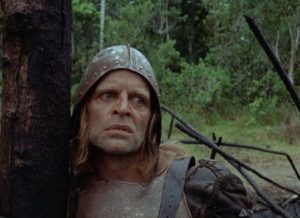 Another interesting aspect to the production was the main actor Klaus Kinski. Herzog had “described his relationship with Kinski as two oppositional forces of Nature that when joined reach a critical mass” (Deep Focus Review). Kinski’s overbearing nature is actually what landed him the part. Before playing in Aguirre, the Wrath of God Kinski played a theatrical Jesus on tour. He would basically stand on a stage with a microphone and rant about how he was Jesus and he would insult the audience who would then insult him back. While he was on the set of Aguirre, the Wrath of God he wasn’t much better. It was reported that one night he was upset about some locals being “too noisy” in their tent so he took his rifle and fired off three shots into the tent. One man was shot in the hand and almost lost his finger but thankfully nobody was killed. Kinski didn’t get in much trouble for his actions, Herzog just took away his rifle. It might seem like a crazy light punishment but it seemed Herzog was a bit crazy as well. Kinski had finally threatened to leave the production altogether and Herzog responded by saying that “the film was more important than either of them—and that if Kinski tried to leave, Herzog would get his rifle and put eight of the nine rounds into Kinski’s head, and then save the last one for himself” (Deep Focus Review) so as you can see both the heads of the production were quite unstable.
Another interesting aspect to the production was the main actor Klaus Kinski. Herzog had “described his relationship with Kinski as two oppositional forces of Nature that when joined reach a critical mass” (Deep Focus Review). Kinski’s overbearing nature is actually what landed him the part. Before playing in Aguirre, the Wrath of God Kinski played a theatrical Jesus on tour. He would basically stand on a stage with a microphone and rant about how he was Jesus and he would insult the audience who would then insult him back. While he was on the set of Aguirre, the Wrath of God he wasn’t much better. It was reported that one night he was upset about some locals being “too noisy” in their tent so he took his rifle and fired off three shots into the tent. One man was shot in the hand and almost lost his finger but thankfully nobody was killed. Kinski didn’t get in much trouble for his actions, Herzog just took away his rifle. It might seem like a crazy light punishment but it seemed Herzog was a bit crazy as well. Kinski had finally threatened to leave the production altogether and Herzog responded by saying that “the film was more important than either of them—and that if Kinski tried to leave, Herzog would get his rifle and put eight of the nine rounds into Kinski’s head, and then save the last one for himself” (Deep Focus Review) so as you can see both the heads of the production were quite unstable.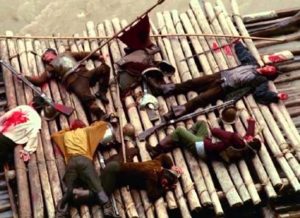 real explosions but when it came to things like blood it was very obviously bright red paint being splattered. One element focused on heavily in the film is noise. Almost the entire film there’s constant chattering of animals in the jungle or the rushing water in the rapids beneath them. Occasionally Herzog would cut all of the noise and make everything disturbingly silent. This was to make the viewers uncomfortable, like the characters were in the movie, because it always followed with a wild attack from the cannibalistic natives hiding in the jungle.
real explosions but when it came to things like blood it was very obviously bright red paint being splattered. One element focused on heavily in the film is noise. Almost the entire film there’s constant chattering of animals in the jungle or the rushing water in the rapids beneath them. Occasionally Herzog would cut all of the noise and make everything disturbingly silent. This was to make the viewers uncomfortable, like the characters were in the movie, because it always followed with a wild attack from the cannibalistic natives hiding in the jungle. 
